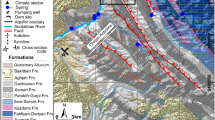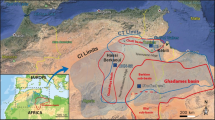Summary
A prediction of the quantity of water likely to escape through cavernous limestone under full-reservoir conditions may be possible based on the knowledge of void space and average velocity of water in limestone. In practice, in place of actual void space, the total cross-sectional area of limestone in the probable zone of leakage and the “void-ratio” are calculated. A statistical approach with the data obtained from planned exploratory drilling and water percolation tests provides values for void-ratio whereas knowledge of detailed subsurface geology helps to deduce the sectional area. The average velocity of water can be obtained from the study of natural tritium in groundwater or injection of chemical and radioactive tracers and various hydrological investigations, such as water-balance calculations in adjacent basins.
Résumé
La prévision de la quantité d'eau qui, sous un réservoir plein, s'infiltrera probablement à travers un calcaire caverneux, peut être possible si l'on se base sur la connaissance de l'espace vide et de la vitesse moyenne de l'eau dans le calcaire. En pratique, à la place de l'espace vide réel, on calcule l'aire totale de la section de calcaire dans la zone d'infiltration probable, et le pour-centage des vides. Une méthode statistique dont les données sont obtenues à partir des sondages d'exploration et des essais de percolation donne des valeurs de pourcentages des vides; cependant la connaissance de la géologie détaillée de la subsurface aide à déduire l'aire de la section. La vitesse moyenne de l'eau peut être obtenue grâce à l'étude du tritium naturel dans les eaux souterraines ou par l'injection de traceurs chimiques ou radioactifs et des recherches hydrologiques variées telles que les calculs de bilan des eaux dans les bassins voisins.
Similar content being viewed by others
References
COCHRAN W. G. (1953): Sampling techniques. J. Wiley & Sons, N. Y., 119.
FISHER R. A. (1958): Statistical methods for research worker. Oliver & Boyd, London, 13th ed., 113 & 174.
KOCHINA P. (1962): Theory of groundwater movement (Translated from Russian by J. M. R. De Wiest). 12 & 448.
Author information
Authors and Affiliations
Rights and permissions
About this article
Cite this article
Gangopadhyay, S. An approach to estimation of leakage from a karstic limestone reservoir. Bulletin of the International Association of Engineering Geology 20, 189–191 (1979). https://doi.org/10.1007/BF02591280
Published:
Issue Date:
DOI: https://doi.org/10.1007/BF02591280




